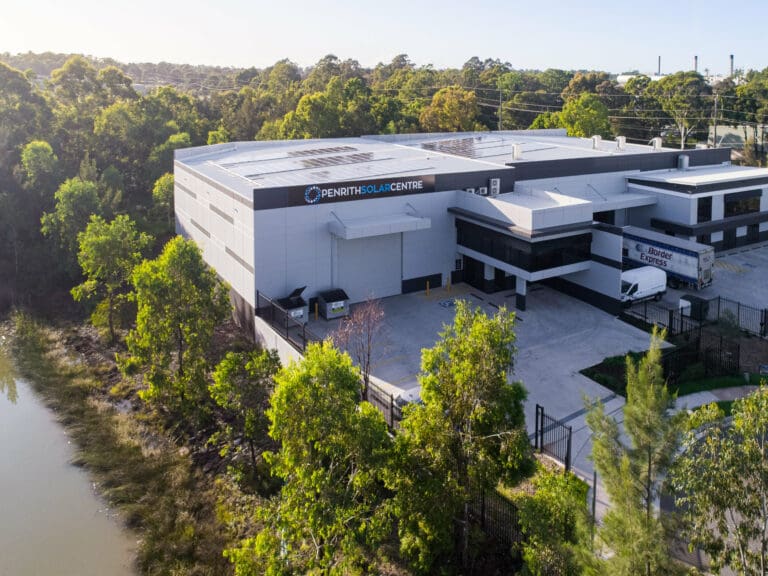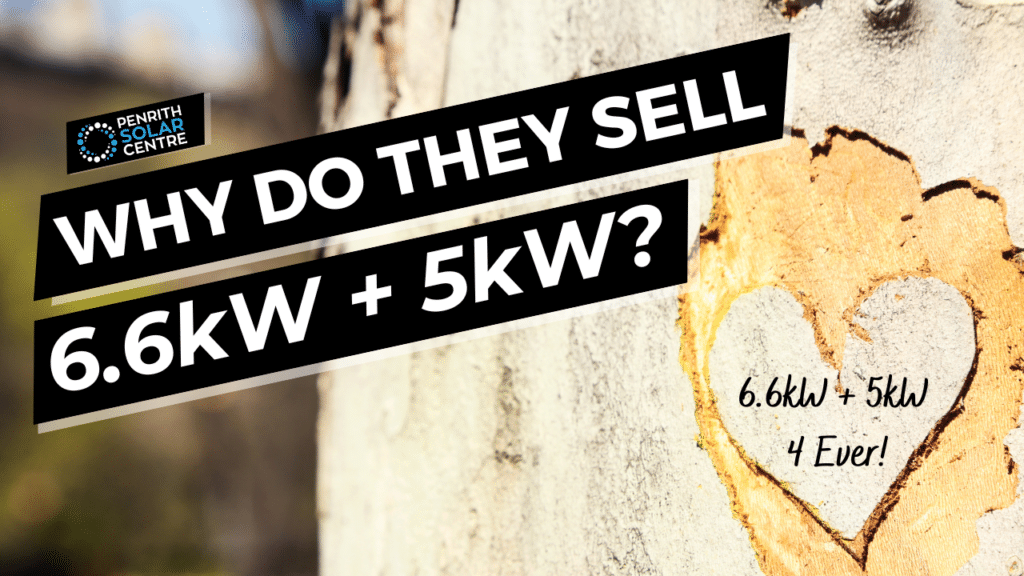
In Australia, 6.6 kilowatt (kW) solar systems paired with 5kW inverters are incredibly common. Why is that?
Solar technology is evolving at a very rapid pace and the truisms that installers could count on just a year or two ago have already been improved and replaced by the latest and greatest tech. 10 years ago, a 3kW system was standard. Then for a while, a 5kW system was preferred. And now, our community is outgrowing the 6.6kW system.
At Penrith Solar Centre, we want you to understand the ins and outs of the solar industry so you can make the most informed choice possible for your unique needs. There are a number of factors to take into consideration when shopping for a solar system. It’s important to speak with a reputable solar installer about your needs as you work together to design a system that helps you achieve your energy goals.
In this article, you will learn:
- Why Do Solar Companies Sell So Many 6.6kW String Systems with 5kW Inverters?
- How Much Does a 6.6kW String System Cost?
- Roof Real Estate: How Many Panels are in a 6.6kW String Solar System?
- How Much Energy Does a 6.6kW String System Produce?
- Should I Install Solar Batteries with a 6.6kW String Solar System?
- How Long is the Payback Period on a 6.6kW String Solar System?
By the end of this article, you will understand why 6.6kW systems became common and why you might want to take the same principles and apply them as you continue your solar journey.
Why Do Solar Companies Sell So Many 6.6kW String Systems with 5kW Inverters?
When we say a solar system is 6.6kW, we’re referring to the power output coming from the solar panels on the roof. A system of that size is usually automatically paired with a 5kW inverter. Many string inverter solar system sales companies will promote this combination. Why is that?
The reason every solar sales company sells a 5kW inverter with 6.6kW of panels is because it’s very easy to get the permission to connect to the grid with those technical specifications. Export limits for single-phase sites don’t go over 5kW, so they slap 6.6kW of solar on the roof because it’s perfectly oversized at 133% to a 5kW string inverter (we’ll explain what this means, shortly).
If a customer wants a larger system, they tend not to customise it. They’ll double it with 13.2kW of solar on the roof and two 5kW inverters. That’s par the course for a lot of string inverter solar systems. Such companies thrive off the repetition of installing this system. They don’t customise the system to match the customer’s needs or goals. They show up on installation day, they always use a single-phase inverter, and they install cheap string systems over and over and over again.
The Clean Energy Council (which makes the rules nationally for solar in Australia), has rules about how solar panels should be paired with inverters. They do this for a couple of reasons. One of those issues is to protect the electrical grid from too many homes with solar exporting electricity back to the DNSP. But it can handle a maximum of 5kW per household.
There is also the issue of calculating the federal government rebate. The amount of STCs (Small-scale Technology Certificates) a household can receive is proportional to the number of solar panels on your roof and the megawatts those panels can potentially produce.

In order to get as many panels as possible on the roof for maximum solar panel production (and maximum STCs), the Clean Energy Council approved the installation of a 5kW inverter with a 6.6kW system nationwide. Such an installation is called “oversized” or “overclocked” because the panels are overproducing power for the inverter to convert and send to the home. Why is this advantageous?
Solar panels rarely operate at peak efficiency. Their power rating is verified in a lab with ideal testing conditions. Most of the year, up on your roof, solar panels are less efficient. The reason for that is that the sun does not always shine on your panels perpendicularly year-round. When the sun hits your panels at a perfect 90°, they are at their most efficient. The sun is lower in the sky in the winter and higher in the sky in the summer. The amount of irradiation varies significantly throughout the year.
Other variables that affect the efficiency of your solar panels is heat. Solar panels operate best around 25° on a cool and maybe even windy day. Dust and dirt buildup all obstruct the panel, dropping the efficiency of the system.
Having more panels producing more power keeps the inverter running at a higher average efficiency year-round. You’ll get greater solar energy production in the early morning and late evening because of this as well.
A 5kW inverter can be oversized by 33% according to the Clean Energy Council requirements. If the solar system outputs more than 6.6kW, the inverter will need an increased capacity if it’s a single-phase site. But if the inverter is larger than 5kW, it would then no longer be compatible with grid requirements. In this case, you can set the inverter to export 5kW maximum back to the grid.
If you’re interested in learning more about oversizing your solar panels, you might want to check out the following article titled, What is Solar Oversizing in a Microinverter System?
If you’re interested in learning more about STCs, you might want to check out the following article titled, How Does the Solar Rebate Work?
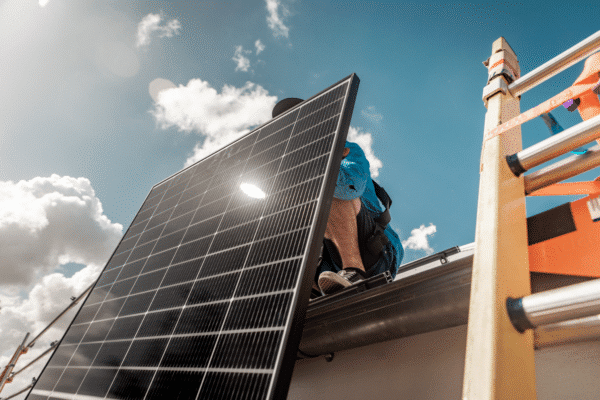
How Much Does a 6.6kW String System Cost Upfront?
It will cost approximately $1 per watt after calculating the STC rebate. So around $6,600. That’s the overall industry average at the moment for a quality string system. Though we’ve seen others advertised at a lower price.
Variables like installation costs can be radically different from installer to installer. There’s also a lot of cheap equipment on the market that doesn’t cost much (it also doesn’t last too long).
We obviously can’t quote a 6.6kW string inverter system for you because we install microinverter solar systems. But you should really be cautious of anyone who promises a 6.6kW string inverter solar system that is significantly higher or lower than around $1 per watt.
If you’re interested in learning more about the differences between string inverter solar systems and how they stack up in performance against microinverter solar systems, you might want to check out the following article titled, Microinverters vs. String Inverters: An Honest Comparison.
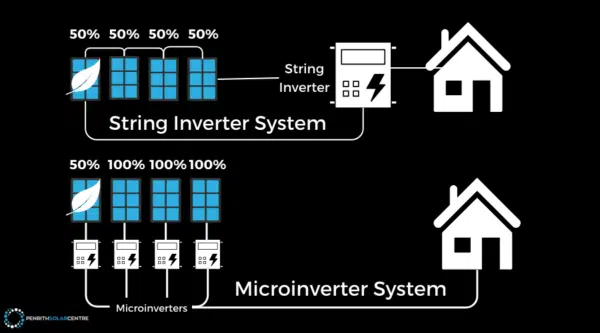
Roof Real Estate: How Many Panels Are in a 6.6kW String System?
For the sake of this article, we’ll use a 400W solar panel as an example. The math on that is relatively simple to work out:
6,600W / 400W = 16.5 solar panels (approximately)
Obviously, no one installs half a panel. And the 400W estimate for the wattage of a solar panel is not what every installer uses. Some put lower-wattage panels on the roof, so there are more of them. If the panels have a higher wattage, there will be fewer of them.
A solar panel is generally about 1.7m2. So then: 1.7m2 x 16.5 solar panels = 28.05m2
And the estimate of the size will depend on how many panels you’re installing up there. If the panel has less wattage, there will be more of them taking up more roof real estate, if the panels have a higher wattage, there will be fewer of them.
If you’re interested in learning more about how the size of your roof affects your installation, you might want to check out the following article titled, How Does Your Roof Affect Your Installation?
Learn more about alternatives to strings!
How Much Energy Does a 6.6kW String System Produce?
There are just too many factors to consider when looking at energy production for a system.
- Location: the geographic location of your home and solar panels with respect to the Equator has a lot to do with energy production.
- Climate: is it overcast often? Clouds interfere with a solar system’s ability to harvest that sweet, sweet sunshine.
- Orientation and pitch of each panel: what direction are your solar panels facing? Are they on a southern-facing roof? What time of day is it?
- Shading: as we mentioned with clouds, shading is directly blocking sunlight from hitting those sleek black panels. Solar panels need light.
- Performance of equipment: is your system working the way it’s supposed to?
- Care and upkeep: are you taking care of your system? Are you monitoring its energy output and how it interacts with the electrical grid?
How much energy a 6.6kW string system produces is really difficult to even guess without some of the information in a few of these bullet points answered.
If you’re interested in learning more about how to design your system to maximise your solar consumption, you might want to check out the following article titled, Which Way Should Solar Panels Face in Australia?
Talk to an expert about efficiency!
Should I Install Solar Batteries with a 6.6kW Solar System?
Absolutely, you should.
They’re crucial for getting your home self-consuming your own energy (and we believe in the importance of self-consuming your own energy).
It’s very difficult to maximise the efficiency of your solar investment without a solar battery or two to help you fully self-consume from your solar system.
For a 6.6kW system, you will most likely have excess energy, especially in the middle of the day when the sun is high in the sky. Without a solar battery, that electricity will be exported back to the grid for pennies per kW.
For more information on whether you should look at investing in a solar battery, you might want to check out the following article titled, Enphase IQ Battery 5P vs Tesla Powerwall 2: Which is Right for You?
How Long is the Payback Period on a 6.6kW Solar System?
This depends on how much your upfront payment for the system will be, what the cost of your energy bills will be, and how much electricity you’re able to self-consume from the solar system.
If a 6.6kW string system costs a little over $6,000, then you need to look at your energy bill saving against that upfront price.
Energy in Sydney is around $0.32 per kWh. The higher that price, the shorter your payback period will be (and the cost of electricity is rising).
If your family uses 25kWh per day, then the cost of importing that electricity directly from the grid will be:
25kWh x $0.32 = $8 per day
The cost of buying that much energy per year will approximately be:
$8 x 365 days = $2,920 in energy per year
That looks like your solar will earn back its upfront cost quickly if the system is only a little over $6,000. However, we have not yet factored in how much energy you’re going to self-consume.
This is where things get a little tricky with figures. Without a solar battery, you probably won’t self-consume more than 60% of your solar unless you work from home or your needs are incredibly low (but if that was the case, you wouldn’t need solar). Of course, the cost of a solar battery will increase the upfront cost, extending your payback period.
There are so many factors to consider when figuring out this equation. Our best suggestion is to ask questions and keep a level head as you decide what will be the best solution for your energy needs and goals. Those needs and goals will be different for everyone.
For more information on solar payback periods, you might want to check out the following article titled, What is the Payback Period for Solar Panels in Australia? However, that article is looking at the payback period for a microinverter solar system.
A string inverter solar system payback period as short as the timeline we mentioned above depends on a lot of things functioning properly. Unfortunately, most string inverter solar systems rarely function at peak efficiency over time. There are issues within their design (central point of failure), their lifespan (requiring replacement every 5 – 10 years), or the difficulties you might have fulfilling warranties if you purchased a system from a sales company who hired a subcontractor to install it.
These are all variables that may or may not happen with your 6.6kW string inverter solar system.
If you’re interested in learning more about the lifecycle of string inverters, you might want to check out the following article titled, String Inverters: Are They Worth It?
Too Much of a Good String
Now that you understand why a 6.6kW string inverter solar system is so often paired with a 5kW inverter. The cost, the size, and the specifics of production factor into the decision to install a system of that size. As energy needs continue to evolve, the standard size of a solar string system will need to evolve as well. It’s the tail-end of the 6.6kW string system’s reign.
At Penrith Solar Centre, we want you to be fully informed, even if you’re planning to install a product that we feel is inferior. Remember to keep your eyes and ears open and ask lots of questions before pulling the trigger on a solar system of any size. A solar consultant worth their salt will work with you to assess your needs and plan out a system just for you.
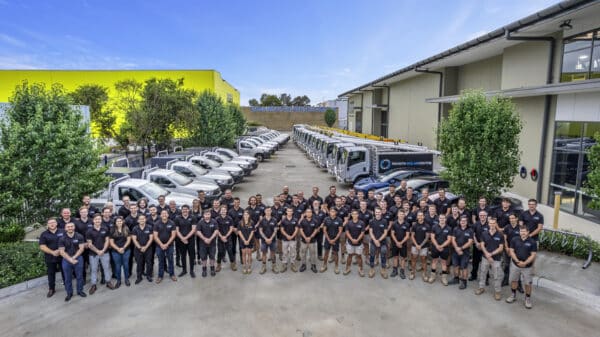
If you’re interested in learning more about the process of choosing the right equipment and the right system for your needs, you might want to start with the following article titled, How to Shop for Your Solar System.

